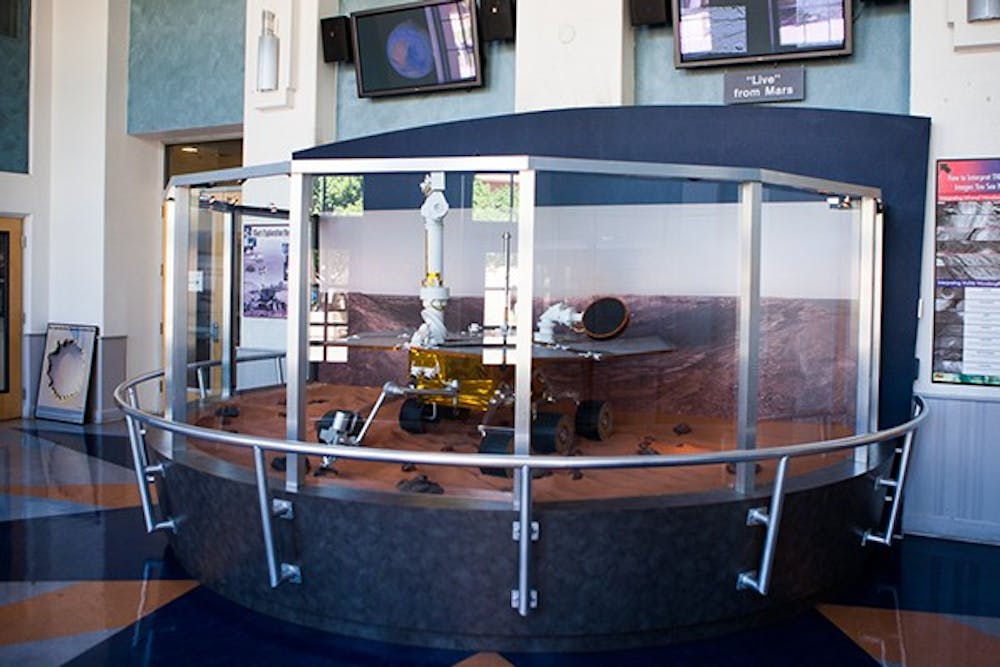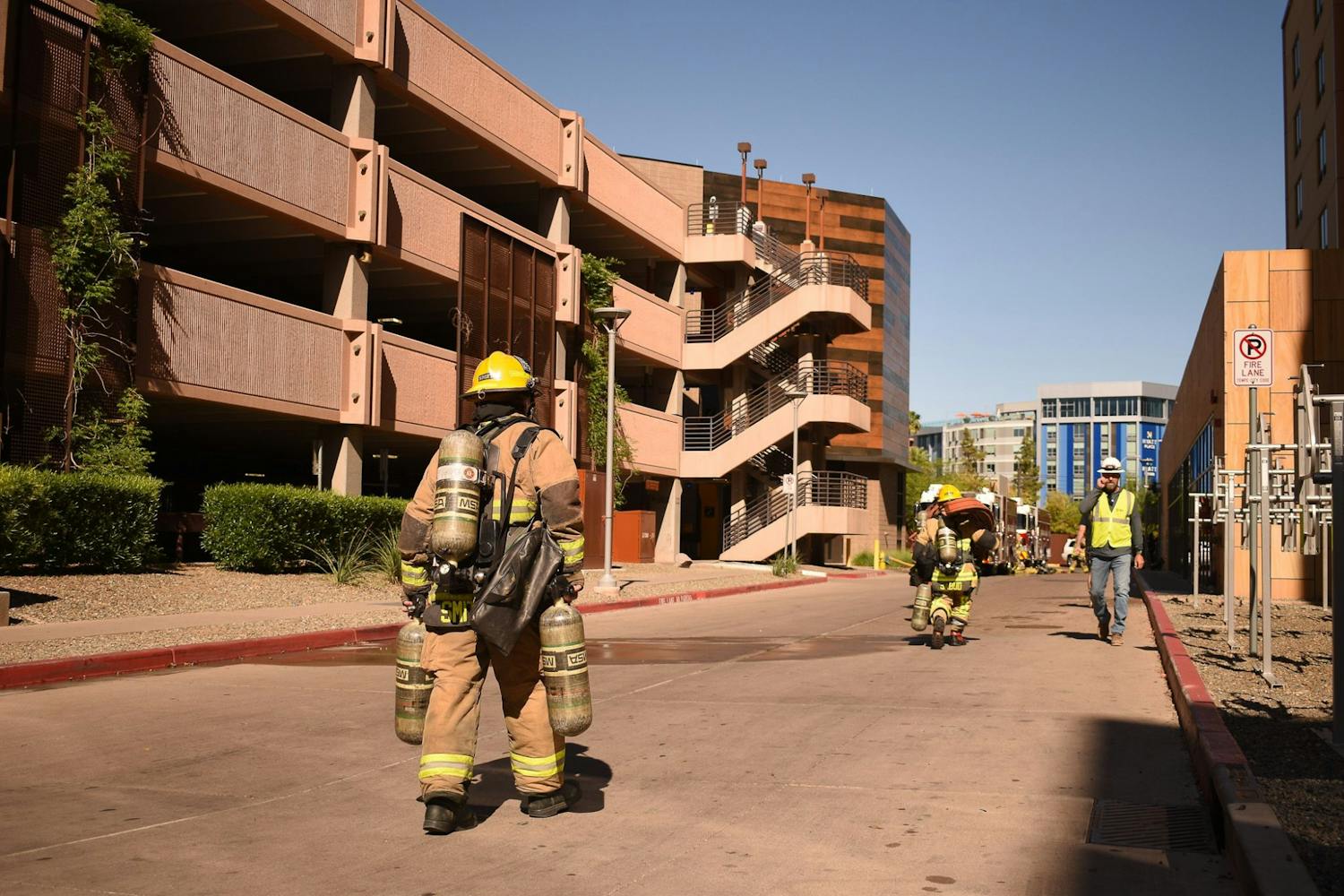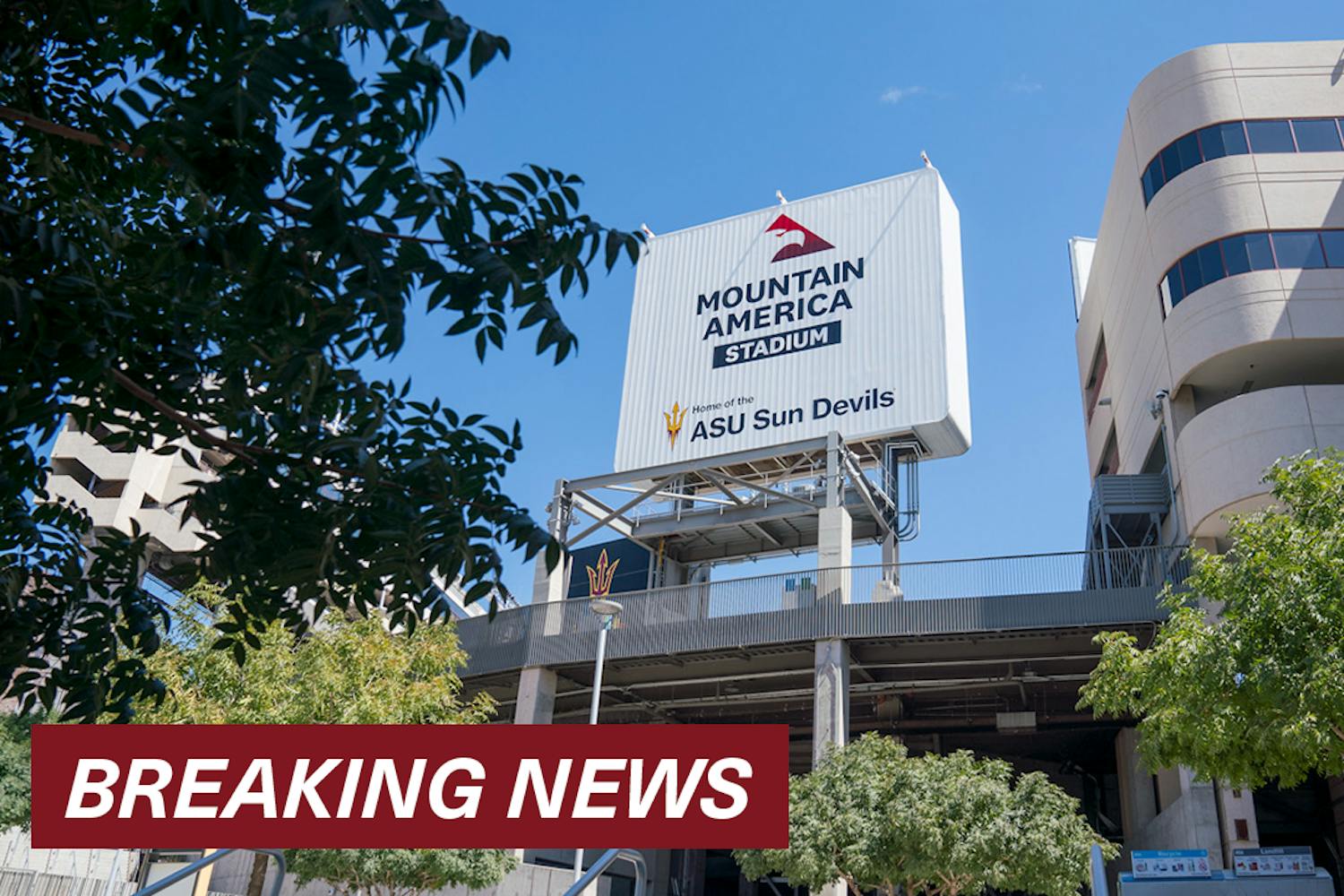 One of the space rovers is being displayed in the Moeur Building. For the first time in 40 years, NASA will be able to take pictures of the atmosphere on Mars using the THEMIS camera designed at ASU. (Photo by Ryan Liu)
One of the space rovers is being displayed in the Moeur Building. For the first time in 40 years, NASA will be able to take pictures of the atmosphere on Mars using the THEMIS camera designed at ASU. (Photo by Ryan Liu)
Correction added.
NASA scientists will soon observe and photograph the surface of Mars during sunrise and sunset for the first time in 40 years by using a thermal camera designed at ASU.
The Thermal Emission Imaging System camera was placed aboard the Mars Odyssey spacecraft, a satellite that orbits the planet, in 2001. This thermal emission imaging system captures pictures of clouds, frost, surface terrain and other features found on the planet.
Originally proposed and designed by Philip Christensen, principal investigator and ASU regents professor, THEMIS camera is controlled by ASU researchers at the Mars Space Flight Facility on the Tempe campus.
Jeff Plaut, a Mars Odyssey project scientist from NASA, said this new orbit is exciting for scientists because multiple atmospheric changes occur on Mars only in the mornings.
“There have not been any systematic observations of the atmosphere and surface of Mars during the morning hours,” he said. “This gives us a chance to observe Mars at that time of day. There are some interesting things that we believe are happening.”
For example, he said the camera’s infrared technology can capture weather changes, seasonal shifts and even wet spots found on craters that have not been studied before.
“We’ll have a chance to observe those in the morning and also measure their temperature,” Plaut said. “Nobody has done that before.”
Additionally, Plaut said some evidence suggests small geysers on the planet’s surface release carbon dioxide in the springtime. If the THEMIS camera captures these images, it will be the first time scientists have observed these geysers during carbon dioxide release.
However, time is running out for the Odyssey to reach the orbit and collect this information.
“This is an old spacecraft,” Plaut said. “We’ve being flying in space for 13 years now. We’re solar-powered, and our power system is not as efficient as it once was.”
He said the new orbit fulfills the scientific purpose of learning more about the planet, but it also has a practical use. The new orbit will fall into the sun’s path so that the solar panels can collect a greater concentration of energy and remain operational for as long as possible.
The Odyssey’s orbit at sunrise and sunset will be achieved November 2015, and the camera will likely continue to capture images until the end of 2016.
Tim Titus, space scientist at the U.S. Geological Survey in Flagstaff, works in the USGS Astrogeology Science Center. It utilizes information captured by THEMIS and other technologies to assist NASA with its missions.
He said the data gathered from THEMIS helps NASA decide on important factors, such as the best rock samples to collect and how to map out the planet’s surface as accurately as possible.
“In a sense, we’re doing the same thing the survey does for Earth, but we just do it for not-Earth: the moon, the planets and some of the other bodies in the solar system,” Titus said.
He said he hopes the Odyssey’s new orbit will explain how surface conditions on Mars change during different times of day. Incidences such as frost, morning fogs and other events occur in the mornings but disappear a number of hours later.
“How do things on Mars change from the morning to the afternoon?” he asked. “We’ll be getting data back from the morning and compare that to what we see in the mid-afternoon.”
Along with the THEMIS camera, ASU is involved with a number of other projects that reveal more about the planet.
Onboard NASA's two Mars Exploration Rovers, Spirit and Opportunity, are small thermal image cameras. Named Mini-TES, these devices measure characteristics of minerals on the surface of Mars as well as the thermal properties of water vapor, ice and other materials.
As with THEMIS, these cameras were proposed to NASA and designed by ASU professor Philip Christensen.
Professor Steven Ruff oversees daily operations of the Mini-TES missions. He said the University has been expanding its influence on space exploration since the early 1990s.
For example, Christensen proposed to have thermal spectrometers fly on the Mars Observer more than 25 years ago. At the same time, another ASU professor in the geology department proposed to send a different camera with the same craft. Both were accepted by NASA.
“The combination of two instruments flying on a Mars mission — that really put ASU in the lead for exploring Mars,” Ruff said. “And we continue to hold that lead over other universities certainly ever since.”
To continue this trend of innovation, Christensen is trying to involve ASU’s research team with NASA’s new rover mission launch scheduled for the next decade.
“(Christensen) just submitted a proposal for a new rover mission in 2020,” Ruff said. “It’s very competitive: We’re one of about 60 proposals. So, we’re crossing our fingers and hoping we get on that one.”
In the meantime, ASU is building a device for an upcoming mission to fly to a near-Earth asteroid, collect samples of terrain and bring it back for study.
Named the OSIRIS-REx Thermal Emission Spectrometer, it is expected to record the thermal and mineralogical properties of material found on the asteroid so researchers can identify the best samples to gather.
“It’s a big deal, because that’s the first time that ASU has actually built an object that will go into space,” Ruff said.
As part of an ongoing effort to make ASU as competitive as possible in space exploration, the ISTB4 building was constructed on the Tempe campus in 2012. It offers multiple clean rooms and new tools so that new technologies, such as OTES, can be built by faculty and eventually sent to NASA for launch.
Ruff said he expects that ASU will continue to make strides in space exploration.
“It’s a combination of the vision from Crow and (Christensen) promoting this idea of trying to build instruments here on campus,” he said. “ISTB4 represents an opportunity for ASU to get in the game of building instruments that go to space.”
Reach the reporter at shari.rose@asu.edu or follow her on Twitter @sharir55
Correction: Because of reporting error, three quotes in this story were incorrectly attributed. It's been corrected.




